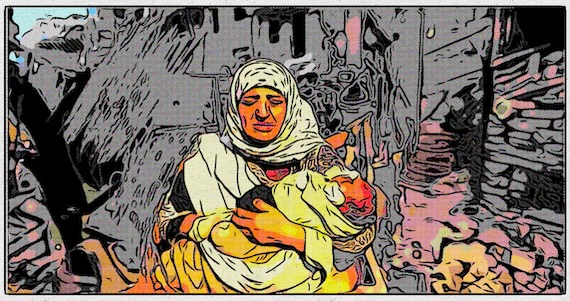Ann Arbor (Informed Comment) – On the Sunday before Christmas, Pope Francis said, “May the weapons be silenced and Christmas carols resound!” according to Kristina Molare at the Catholic News Agency.
The Pope continued, in a clear condemnation of the Israeli government, “With sorrow I think of Gaza, of so much cruelty; of the children machine-gunned, the bombing of schools and hospitals… So much cruelty!”
He said, “Let us pray for a ceasefire on all war fronts, in Ukraine, the Holy Land, in all the Middle East and the entire world, at Christmas.”
On Saturday, he had been equally forthright on Israel’s atrocities in Gaza, saying, “Yesterday they did not allow the Patriarch (of Jerusalem) into Gaza as promised.”
“Yesterday children were bombed. This is cruelty, this is not war.”
The Pontiff underlined, “I want to say it because it touches my heart.”
(Latin Archbishop Pierbattista Pizzaballa did ultimately manage to visit Gaza City on Sunday to conduct mass for the Christian Palestinian refugees from Israeli bombardment there, in coordination with Israeli authorities. But apparently until the Pope spoke out, the Israeli military had denied him permission.)
Francis’s increasingly outspoken condemnation of Israel has caused several controversies this fall. In a new book first published in Italian in November, the pope called for a painstaking investigation of whether Israel is guilty of genocide in Gaza. (See below for an excerpt from my earlier analysis of these passages.)
On December 7, artisans from the Bethlehem Christian community presented a nativity scene at the Vatican’s Paul VI Hall. The installation was headed by Johny Andonia, 39. At the last moment, he decided to wrap the baby Jesus in a keffiyeh, the patterned scarf that is commonly worn by men in the Levant, Iraq and Arabia, but which has come to symbolize the Palestinians in particular. He said the scarf was a symbol to demonstrate the “existence” of Palestinians. After an outcry from Israel and its supporters ensued, the scarf was removed after three days.
Bethlehem in Palestine has a population of 29,000 about 3,000 of them Christians. Palestinian Christians have suffered from Israeli colonial brutality like all other Palestinians.
I wrote on November 21,
Pope Francis has a new book, Hope never disappoints. Pilgrims towards a better world. . . The Pope mentions Gaza on several occasions in the book. At one point he expresses concern about migration crises around the world, colored as they are by “violence and hardship,” in the Sahara, the Mexican-US border, and the Mediterranean, “which has become a large cemetery in the past decade.” He adds, “also in the Middle East,” because of the “humanitarian tragedy” in Gaza . . .
The Catholic leader laments that so many Ukrainians have been forced to flee, and praises countries that took them in, such as Poland. He then turns to the Middle East, where, he says, we have seen something similar . . .
Francis said he was thinking especially of those who leave Gaza in the midst of the famine that has hit the Strip. Experts estimate that about 100,000 Palestinians from Gaza managed to flee to Egypt before Israeli Prime Minister Benjamin Netanyahu occupied the Rafah crossing with Israeli troops.
Then Pope Francis dropped his bombshell. According to some experts, he wrote, “What has been happening in Gaza has the characteristics of a genocide.”
He insisted that a painstaking investigation be carried out to determine whether the situation fits the technical definition formulated by jurists and international organizations. He is likely referring to the Rome Statute of the International Criminal Court and the Genocide Convention of 1948, on the basis of which the International Court of Justice is deliberating on whether what the Israelis are doing in Gaza is a genocide . . .

“Pieta,” Digital, Dream / Dreamland v3 / Clip2Comic, 2024
His last mention of Gaza comes in a passage where he recalls a photograph of a Palestinian grandmother in Gaza, her face not visible, holding in her arms the lifeless body of her five-year-old granddaughter, who had just been killed in an Israeli bombing, along with other family members. He notes that the image has been called “The Pieta of Gaza.”
The Encyclopedia Britannica explains, “Pietà, as a theme in Christian art, depiction of the Virgin Mary supporting the body of the dead Christ. . . . the great majority show only Mary and her Son. The Pietà was widely represented in both painting and sculpture, being one of the most poignant visual expressions of popular concern with the emotional aspects of the lives of Christ and the Virgin.”

Michaelangelo, “Pietà,” Public Domain.
He says that the photo, taken in a hospital morgue, conveys strength, sorrow and the unimaginable pain inflicted by war. He ends by again insisting that innocents must be protected even in the midst of warfare, a principle, he says, that is engraved on the hearts of all people.
The consequence of the Pope’s comments throughout is a humanization of the Palestinians — a humanization of which US and British media outlets have largely proved themselves incapable. The only way they can be all right with over 17,000 dead children in Israel’s campaign against Gaza is that they do not see them as truly human. Otherwise, even the death of one little granddaughter would have us all weeping uncontrollably.
Not only does the Pope humanize Palestinian suffering, refusing to lose his empathy in the face of the magnitude of the slaughter and the sheer number of children in burial shrouds, but in a sense he even divinizes Palestinian suffering. The dead little girl in her grandma’s arms is a Christ-like figure — Christ-like in her innocence, which did not prevent her from being brutally killed. And the heart-wrenching mourning of her grandmother is like the grief of the Mother Mary over her crucified son, himself the incarnation on earth of the divine.


 © 2025 All Rights Reserved
© 2025 All Rights Reserved